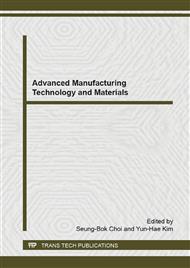p.341
p.346
p.350
p.354
p.359
p.365
p.369
p.373
p.377
The Effects of Cutting Parameters on Work-Hardening of Milling Invar 36
Abstract:
An experiment of face milling of Invar36 was conducted by using coated carbide insert, the microhardness was tested and the metallographic structure was observed to figure out the principles of work-hardening. The results showed that the depth of work-hardening ranges from 80μm to 160μm among the parameters selected in the experiments. The degree and the depth of work-hardening were significantly affected by the axial depth of cut and feed per tooth. The degree and the depth of work-hardening showed a tendency to increase with the increase of the axial depth of cut and feed per tooth. Compared with the axial depth of cut and feed per tooth, cutting speed had less influence on the degree and depth of work-hardening. The degree and depth of work- hardening decreased slowly with the increase of cutting speed. Metallographic observation showed that work-hardening layer consisted of the thermal force influenced layer and the force influenced layer, while the amorphous metallographic structure was observed in the thermal force influenced layer, and lattice distortion was observed in the force influenced layer.
Info:
Periodical:
Pages:
373-376
Citation:
Online since:
January 2015
Authors:
Keywords:
Price:
Сopyright:
© 2015 Trans Tech Publications Ltd. All Rights Reserved
Share:
Citation:


